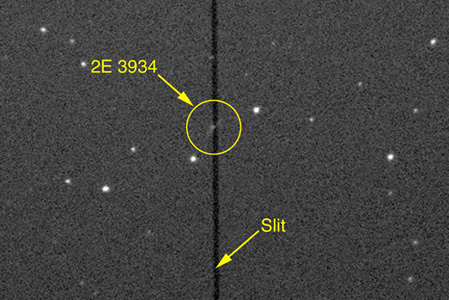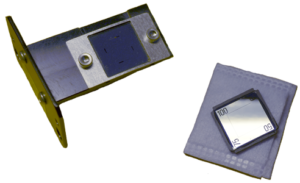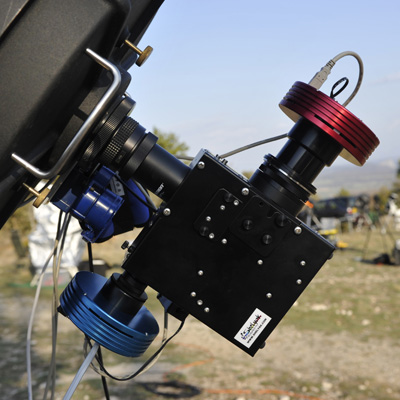Shelyak LISA Spectroscope
The LISA is the most sensitive instrument in our product range. Thanks to its internal reducer and low resolution, it is the undisputed master of faint objects such as novae & supernovae, planetary nebulae, comets, symbiotic stars, cataclysmic variables, galaxies…
A high-luminosity instrument
The LISA spectroscope is dedicated to the spectroscopy of faint objects such as comets, novae, supernovae, faint variable stars, the redshift of distant galaxies or quasars, or the confirmation of planetary nebulae. Its optical design has been specially studied for the observation of this type of object, with custom-made optics. Its calibration module (optional) enables easy calibration using an Argon/neon lamp, providing a large number of emission lines over the entire LISA spectral range. The same module is equipped with a tungsten lamp for flats.
A wide spectral range
With a resolving power of R = 1,000 with a 23 µm slit, its spectral range covers the entire visible range between 400 and 700 nm, and even extends into the near UV and near IR.

Example of a raw spectrum on BD+59 2829, a Be star of magnitude V=9.9 obtained with a LISA
Aperture
The LISA’s F/5 aperture makes it particularly well suited to faint objects, and it can be installed on telescopes or scopes natively f/5, but also on any type of Schmidt Cassegrain or Ritchey Chretien telescope using a focal reducer to bring the native focal length of this type of telescope, generally f/10 or f/8, down to a focal length close to 5.
Guiding system
Thanks to its mirror slit, the Lisa accurately positions and holds the target in the slit. A guiding camera (not supplied) enables the telescope’s movements to be controlled (autoguiding), ensuring optimum observation.

Field of the LISA autoguider with the slit positioned vertically, on a Seyfert galaxy
Interchangeable slit
The interchangeable slit supplied as standard (15-19-23-35µm) makes it possible to adapt the instrument to any observational situation, giving priority to resolution or brightness if required. Other slits are also available as options (wide slits, photometric slits), to further extend the possibilities.
Mechanical interfaces
The LISA is supplied as standard with a 2″ nosepiece. The nosepiece can be removed to access an T-mount female thread (M42x0.75mm thread). For mounting on a classic Schmidt-Cassegrain telescope (2″ external thread), you’ll need the BA0027 variable T-adapter.
The interface with the acquisition camera is also a T-mount thread (M42x0.75mm) with a 54.9 mm backfocus, while the guiding camera port is C-mount with a 17.5 mm backfocus.

For ATIK cameras, you need a 13mm long ring (13mm mechanical backfocus), supplied with the LISA. We offer a wide choice of adapter rings in our accessories catalog.
Applications
- Calculating the redshift of distant galaxies and quasars
- Confirmation of Planetary Nebula candidates
- Spectra of faint Be stars
- Studies of star spectral classes
- Spectra of faint objects (Novae, Supernovae, Comets)
Technical Specifications
- Collimator F=130mm F/5
- High efficiency thanks to internal focus reducer
- Resolution power R ~1000 with a 23 µm slit
- Grating 300 tr/mm blazed à 500nm
- Visible domain (400-700nm)
- Slit 15/19/23/35µm
- Slit length : 4 mm
- Weight: 1.4 kg (w/o caméra)
- Telescope Interface T-mount (M42*0.75), backfocus 41mm
- Science camera interface, T mount, M42*0.75, backfocus 54.9 mm
- Guiding camera interface, C-mount, backfocus 17.5 mm
In the Box
- LISA Spectroscope
- Interchangeable slit : 15, 19, 23, 35μm
- Adapter for 13mm backfocus camera
Manual & Warranty
Demetra Software
User manual.
Dimensions
Live observations with a LISA (online workshop)
Shelyak 1-Year Warranty






